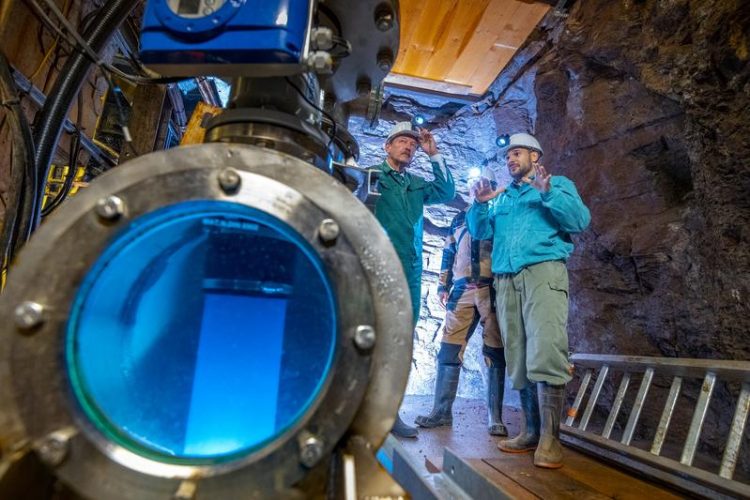"Airlift" facility: TU Freiberg tests new mining technology in research and training mine

(f.l.) Prof. Carsten Drebenstedt, Wolfgang Gaßner and Shevchenko Oleksandr at the new "Airlift" facility in the research and training mine. Photo: Detlev Müller / TU Bergakademie Freiberg
On the new six-metre-high test rig, researchers at the Technische Universiät Bergakademie Freiberg are testing the transport of the crushed material to the surface via a borehole.
The material is sucked out of a closed cavern (underground cavity) and crushed with the aid of compressed air and water and transported to the surface.
“The intervention at the surface is minimal. The resulting cavities are later filled again. Nobody has to go underground,” explains Prof. Drebenstedt.
The Freiberg scientists are now investigating the optimum operating parameters for the new borehole technology in a practical manner in the new “Airlift” facility in the university's own research and training mine “Reiche Zeche”.
The results should provide information about the operating conditions, performance and costs of the plant, which will be built in 2020 as an industrial pilot plant in Katowice, Poland.
The process can be used to extract various raw materials. Initial experience has been gained with uranium, phosphate and coal.
The research work is part of the research project “HydroCoal Plus” funded by the European Union within the framework of “HORIZON 2020 / 7th Research Framework Programme” and will be carried out together with Polish and Czech experts.
Prof. Dr. Carsten Drebenstedt, Phone: +49 3731/39-3373
Media Contact
More Information:
http://www.tu-freiberg.de/All latest news from the category: Earth Sciences
Earth Sciences (also referred to as Geosciences), which deals with basic issues surrounding our planet, plays a vital role in the area of energy and raw materials supply.
Earth Sciences comprises subjects such as geology, geography, geological informatics, paleontology, mineralogy, petrography, crystallography, geophysics, geodesy, glaciology, cartography, photogrammetry, meteorology and seismology, early-warning systems, earthquake research and polar research.
Newest articles

Bringing bio-inspired robots to life
Nebraska researcher Eric Markvicka gets NSF CAREER Award to pursue manufacture of novel materials for soft robotics and stretchable electronics. Engineers are increasingly eager to develop robots that mimic the…

Bella moths use poison to attract mates
Scientists are closer to finding out how. Pyrrolizidine alkaloids are as bitter and toxic as they are hard to pronounce. They’re produced by several different types of plants and are…

AI tool creates ‘synthetic’ images of cells
…for enhanced microscopy analysis. Observing individual cells through microscopes can reveal a range of important cell biological phenomena that frequently play a role in human diseases, but the process of…





















